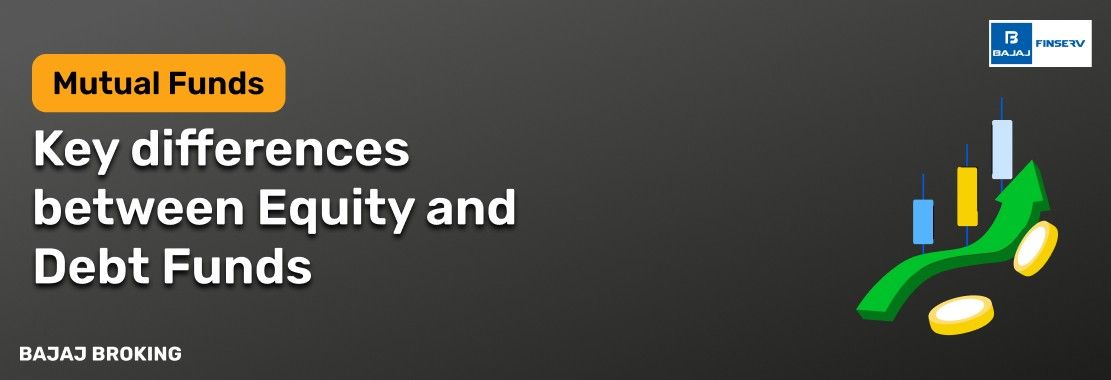Equity and debt funds are two primary types of mutual funds that differ in terms of risk, return potential, and asset allocation. Equity funds invest in shares of companies and are typically associated with market-linked fluctuations. They may suit those who can withstand volatility in pursuit of capital appreciation.
Debt funds, on the other hand, invest in fixed-income securities like bonds, government securities, and debentures. These are considered relatively stable in terms of return, although they still carry risks like interest rate fluctuations and credit risk. Understanding these core differences is essential before choosing the right fund for a financial goal.
What is an Equity Fund?
An equity fund is a mutual fund that primarily invests in stocks or equities of publicly traded companies. These funds aim to generate returns by participating in the growth potential of various sectors and industries. The performance of an equity fund is directly linked to the stock market’s performance.
Equity funds are further classified into categories such as large-cap, mid-cap, small-cap, multi-cap, and sectoral funds. Each category has a distinct risk-reward profile. Investors in equity funds must be prepared for short-term market volatility. These funds may be suitable for long-term financial planning, where capital growth is the primary focus.
Benefits of Investing in Equity Funds
Potential for long-term capital growth if held through market cycles.
Offers diversification across multiple sectors and companies.
Managed by professional fund managers who actively rebalance portfolios.
Tax benefits are available under specific schemes, such as ELSS.
Accessible through SIPs, allowing disciplined investment.
Equity funds may help investors participate in the broader economic growth. They allow even small investors to access a basket of stocks without needing to pick individual shares. However, returns may vary widely in the short term based on market sentiment and economic indicators.
What is a Debt Fund?
A debt fund is a mutual fund scheme that invests in fixed-income instruments such as corporate bonds, treasury bills, government securities, and money market instruments. These funds are designed to offer regular income and lower volatility compared to equity funds.
The risk in debt funds is not eliminated; it stems from factors such as interest rate changes, credit ratings of underlying securities, and market demand. Debt funds are typically used for capital preservation and short to medium-term financial goals. Their performance depends on macroeconomic trends and interest rate cycles.
Benefits of Debt Funds
Provide relatively stable returns due to fixed-income instruments.
Offer better liquidity compared to fixed deposits.
Useful for short- to medium-term financial planning.
Different categories available (liquid, ultra-short, gilt, corporate bond funds).
Tax-efficient if held longer than 3 years (due to indexation benefits).
Debt funds are often selected by investors looking to park money for predictable returns without too much exposure to market swings. They offer flexibility in terms of tenure and options like growth or dividend plans.
Differences Between Equity and Debt Funds
Feature
| Equity Funds
| Debt Funds
|
Investment Focus
| Shares of listed companies
| Bonds, debentures, government securities
|
Risk Level
| Higher due to market volatility
| Lower but subject to interest rate and credit risk
|
Return Expectation
| Market-linked and variable
| Relatively stable
|
Investment Horizon
| Long-term
| Short to medium term
|
Ideal For
| Capital appreciation
| Regular income and capital preservation
|
Understanding the structural differences helps in aligning fund choices with personal financial goals and risk appetite.
Factors to Keep in Mind Before Investing in Equity Mutual Funds
Understand your risk profile and ability to handle market volatility.
Choose the category of equity fund based on investment horizon.
Past performance is not a guarantee of future returns; look at long-term trends.
Review the fund manager’s experience and the fund’s consistency.
Check the expense ratio and exit load charges.
Equity funds are best approached with long-term goals in mind. Regular reviews and SIP-based investments can reduce timing risk.
Factors to Keep in Mind Before Investing in Debt Mutual Funds
Assess the fund’s credit quality and underlying instruments.
Understand interest rate risk; rising rates can reduce bond value.
Look for liquidity features and the fund’s exit load terms.
Choose based on duration: short-term for liquid funds, longer-term for gilt or bond funds.
Consider tax implications if holding less than 3 years.
Debt funds are suitable for conservative investors, but one must evaluate fund categories and associated risks before investing.
How to Choose the Right Investment
Choosing between equity and debt mutual funds depends on your investment goal, risk tolerance, and time horizon. If you aim for long-term capital growth and can withstand volatility, equity funds may align better. For stable returns or short-term goals, debt funds are often preferred.
Some investors also use hybrid funds to balance both equity and debt. It’s essential to assess your financial plan, liquidity needs, and market conditions before selecting the fund type. Reviewing fund performance and consistency helps make informed decisions.
Conclusion
Equity and debt mutual funds offer distinct advantages and risks. While equity funds are linked to market movements and offer growth potential, debt funds are relatively stable but still carry risks related to interest rates and credit quality.
By understanding these differences, investors can make better choices aligned with their goals. Mutual fund investments must be periodically reviewed and matched with personal risk preferences and timeframes. It’s not about choosing one over the other; it’s about choosing what fits your financial journey.





